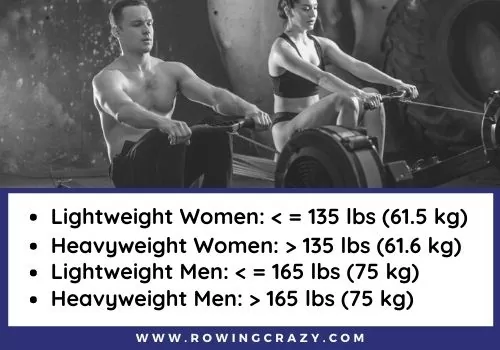
Hi friends! It’s your favorite rowing buddy Petra here to talk today about rowing weight classifications, especially what is considered lightweight and what is heavyweight in on-the-water rowing.
Lightweight categories apply to rowers weighing no more than 160 pounds for men and 130 pounds for women. Beyond these limits, you will have to compete in the Open categories, or what many people refer to as heavyweight.
Whether you are interested in rowing yourself or you just like to watch, there’s a place for everyone in the rowing community.
You’ve probably seen a national or local race, or even an Olympic programme, that mentioned lightweight events, such as a lightweight double, lightweight men, women lightweights, and so on and so forth.
You might have wondered what it all meant!
Let me break down all the terminology and qualifications that you would need and what the differences are between weight classes.
Grab a cup and let’s get started!
Rowing Weight Classes
There are two weight classifications in rowing—lightweight and what is often referred to as “heavyweight”—further categorized as male or female and by the different age brackets. Later in this article, I will explain more about the “heavyweight” category, and why you don’t see heavyweight categories during races.

How Much Do You Have to Weigh to be a Lightweight Rower?
When speaking of collegiate-level rowing in the US, here are the weight limits:
- A male is eligible to compete in lightweight rowing if his weight does not exceed 160 pounds (or 72.6 kg).
- A female can compete in the lightweight division if her weight does not exceed 130 pounds (or 59.0 kg).
In World Rowing competitions, the crew/team weight limits for the lightweight categories are:
- Members of lightweight men’s teams must weigh no more than 159.8 pounds (72.5 kg), with an average crew weight not exceeding 154.3 pounds (70 kg).
- Members of lightweight women’s teams must weigh no more than 130 pounds (59 kg), with an average crew weight not exceeding 125.6 pounds (57 kg).
- Male rowers for single sculls should weigh no more than 159.8 pounds (72.5 kg).
- Female rowers for single sculls should weigh no more than 130 pounds (59 kg).
How Much Do You Have to Weigh to be a Heavyweight Rower?

Like you may have noticed, you won’t see any races or categories for “heavyweight” rowing. Technically, there is no heavyweight division, in the same sense that boxing or wrestling have heavyweight categories.
Anything lower than 160 pounds for men and 130 pounds for women are classed as lightweight. Anything above those limits will be considered NOT lightweight and are categorized as open weight class.
In other words, if you aren’t a lightweight, then you are in the open weight class.
Open weight includes anyone and everyone who isn’t a lightweight.
And even a lightweight event is up for debate.
- Learn More: Is Rowing a Hard Sport to Learn
Is Lightweight Rowing Going Away?
It certainly appears to be circling the drain, as they say. Which means it might be on the way out.
At the last few regattas I went to, there were no rowers in the youth rowing teams (e.g. 16 and under, or 23 and under) who qualified for the lightweight rowing class, so everyone rowed in the open categories.

People do seem to be getting heavier and heavier (as well as taller), and many people feel that, in today’s world, separating rowers by age and sex is enough.
- Learn what is a Rowing Crab
Why Are the Olympics Getting Rid of Lightweight Rowing?
For the same reasons mentioned above.
While the Olympic Committee was expected to eliminate the lightweight rowing classes for the 2024 Paris games, they instead delayed making a decision for one more cycle. However, many believe that the Olympic Games in 2028 (Los Angeles) will remove the lightweight rowing category and simply add more age categories.
The Olympic Committee has also talked about adding coastal rowing to the opportunities that rowers have to compete. This would involve rowing on the open ocean, right along the coast, just past where the waves break.
This would be super exciting! Most rowers are accustomed to flat lakes or going downstream, but to fight the ocean current, ocean swells, and maybe seals and other wildlife would make for an exciting adventure I would love to watch.
Los Angeles would be the perfect venue for this. Imagine sitting on the beaches of Malibu, watching the rowers compete! Sounds like a good time in my book!
Is Lightweight or Heavyweight Rowing Faster?

Contrary to what you may believe, it is open (aka heavyweight) rowing that is a bit faster than rowing lightweight.
While you might think that elite rowers, such as in the Olympic Games, would all be lightweight, this isn’t the case.
This is because anyone who doesn’t qualify for lightweight rowing means that they are probably taller, and while this does add extra weight to the boat, taller rowers—especially male rowers—tend to be faster.
Extra height means extra weight, but that height is an advantage when it comes to rowing ( learn rowing height requirements here ). Statuesque people can put more power behind the oar, even if the boat itself weighs more.
Clubs sometimes try races between open weight and lightweight rowing teams (learn what is a rowing team is called), but it’s very rare for a lightweight division to win over heavyweight teams in a regatta.
If I were to place bets between these two, I would pick the average weight (or open weight) rowing team over the smaller rowers.
What Is the Ideal Weight for Rowing?

This is a matter of debate, but generally speaking, you want a rower that has a minimum amount of body fat.
Some people feel that male rowers should weigh about 205 pounds and female rowers should weigh about 160 pounds. This is based on the assumption that male rowers have 8 percent (or less) body fat, while female rowers have no more than 14 percent body fat.
More important than weight, however, is height. The perfect rower is taller than average, with long arms and legs.
If they don’t go into basketball, rowing is the perfect sport for tall individuals. FYI: You might also like to read our article about what makes a good rower for more tips and advice.
What Are the Lightweight Rowing Categories for Indoor Rowing?
If you weren’t aware of it, there is a World Rowing Indoor Championship that takes place at different venues around the globe.
Chances are that you can find a national or local rowing event in your state (in the USA) or even in other countries, such as the UK and New Zealand.
Local or national events may have different requirements, but for the World Championships, the weight limits are:
Weight Requirements

- Lightweight Women: <= 135lbs (61.5kg)
- Heavyweight Women: > 135 lbs (61.6kg)
- Lightweight Men: <= 165lbs (75kg)
- Heavyweight Men: > 165lbs (75kg)
As with on-the-water rowing, you will find racing events for lightweights (e.g. women lightweight or youth lightweight rowing), but you won’t see the word “heavyweight” mentioned.
You can enjoy the World Rowing Indoor Championships at the event, and they are also doing them virtually.
The next indoor championship is held in Toronto, Canada, in late February 2023. It’s not too late to qualify!
When Do You Do a Weigh-In for a Regatta?
This can vary from state to state and country to country, so if you want to compete, you should check the rules of that particular regatta.
Generally speaking, most regattas want rowers to weigh no more than 2 hours before the event. The coxswain, by the way, doesn’t have to weigh in.
Some regattas will allow you to weigh in the night before, but those are few and far between.

I’ve found that once all team members are accounted for, the coxswain usually takes them to the main venue where they will present ID and be officially weighed before the race. This is to ensure that everyone is who they say they are, and so that you can’t drastically change your weight in an hour or two.
This also allows for substitutions if necessary. If for some reason a rower doesn’t qualify for a lightweight rowing event, or if they want to change from an open event to a lightweight event, changes can still be made if there is time to do so.
I haven’t seen problems like this at weigh-ins, but I’ve heard stories that this sometimes happens.
The Bottom Line
Whether you’re aiming to win a gold medal or you simply enjoy the competitive nature of rowing, you’ll find a place for yourself regardless of your age, weight, or skill level.
I think that’s one of the things that makes rowing regattas so exciting and appealing. No matter your age, skill level, or weight, you can enjoy rowing races all season long.
Keep rocking and rowing on, friends!
Written by Petra Amara – RowingCrazy.com
CEO & Founder of RowingCrazy, National Rower, Coxswain Womens Eight Team, Rowing Coach & Writer
Petra is a Mother of two and owner of Rowingcrazy.com. Petra lives and breathes rowing, she also has a passion for writing which lead her to start RowingCrazy.com to share her rowing experience and expertise with others.








Pingback: Indoor Rowing Weight Categories for Men & Women [Complete Guide]
Pingback: What Is the Boat Called in Rowing? | Rowing Crazy
Pingback: What Is Sculling in Rowing | Rowing Crazy